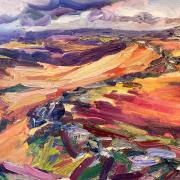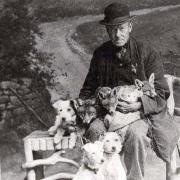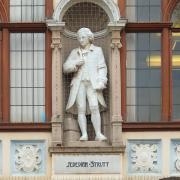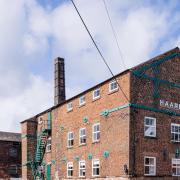Penelope Baddeley visits international award-winning blacksmith Darren Ainsworth at Blackwell Hall farm, near Buxton

The rhythmic clink of hammer on metal alerts the visitor that they have arrived at the Georgian Forge, which is otherwise unannounced by sign or direction and is hidden away in an old stone outbuilding in the corner of Blackwell Hall farm, near Buxton.
It’s broad daylight but the smithy is a place of soot darkened corners; illuminated only by the orange glow of coke from the forge and the warm personality belonging to its resident blacksmith Darren Ainsworth.
He beams out from the dark forest of ironwork which dangles from every square inch of the ceiling and offers a weathered craftsman’s hand, the texture of leather.
Darren, aged 47, is an international award-winning traditional blacksmith who specialises in bespoke hand-forged ironwork, which can be found featured everywhere from solid church doors to a footpath art installation on Mam Tor.

The Bedfordshire-born lad was lured to Buxton at the age of 21 after visiting friends in Derbyshire and being ‘inspired by the hills and the lovely terrain.’
He was desperate to escape a job at the vehicle company Vauxhall where he had been shut in an airtight room for 12 hours at a time and he had a ‘naïve’ plan to get a job as a farrier (or shoeing smith).
‘Nothing at school inspired me except art and woodwork and I’m very practical and like being outside,’ said Darren.
He tramped about the countryside in a 60-mile radius round Buxton trying to get the start he needed. When the job didn’t materialise he enrolled on the UK’s first pre-farrier course, learning about the anatomy of horses and basic forge work. It was based in Warwickshire so he slept nearby in his van every night for eight months and lived hand-to-mouth. He then undertook a shoeing smith apprenticeship at Knutsford in Cheshire, travelling each day from his Buxton base for the four year duration of the course.
The course hammered home the seven pure principles of blacksmithing – the techniques which have held true since the Iron Age and include the methodology of ‘Drawing out’, ‘Twisting’, ‘Jumping’, ‘Bending’ a piece of hot metal on an anvil, ‘Punching’ a hole and ‘Splitting’ it with a tool as well as the most difficult discipline – ‘Forge welding’, where two ends of a piece of metal are joined together.
‘As many as four of these techniques can be used in the creation of the simplest concave horse shoe,’ explained Darren.
As Darren’s shoeing work slowly and gradually built up around Buxton, he opted to return to living in the van to keep start-up business costs at a minimum and he began in earnest to practise and explore the ancient blacksmithing techniques at a forge he had set up on rented land. He rejected the option of using modern power tools used in metal work and focused solely on working with hand tools.
A self–proclaimed purist Darren bemoans the rarity of blacksmiths who work in this traditional way.
He said: ‘I wanted to focus on traditional forging methods as opposed to fabrication. A lot of blacksmiths machine weld. But what really inspired me were the pieces of ironwork out there – agricultural, architectural and domestic – that were made with primitive tools. It is very humbling.
‘Inherent in a simple latch, hinge or gate is an alchemy of process and structure that many a modern blacksmith would marvel at and be confounded by. You ask yourself “How the hell did they make that?”
‘A lot of these old techniques have been lost as these days many people who are stuck in a corner with a job will use modern techniques – buzz a bit of weld on it and it’s done – but I like things to fit together properly, like the workings of a clock.
‘Everything I do, everything I make and pursue is done in the traditional manner. My life is a homage to the skills of the people who went before me.’
Darren’s increasing fascination with the history of his craft led him to travel across Europe and America attending ‘Forging’ events, where he would pick up new skills and look at ironwork on historic buildings. He remains inspired by the texture, character and naïve beauty and workmanship of early pieces.
He said: ‘I’d take hundreds of pictures, picking out traditional techniques and patterns and then I’d come home and practise them from 8am to 10pm at night. I’ve never really been money driven, not even now. It has always been about pursuit of the craft.’
Darren’s business was now building steadily and he began to perfect and explore new techniques in his commissions, using his artistry to create figures in his ironwork such as animal heads.
Slotted into a rack at the back of the arched wooden door leading to the interior of the forge are rows of worked pieces of iron for fireside sets, featuring the heads of cats, dogs, rams and a multitude of animals – a reference to the imagery on early medieval Viking and Saxon ironwork, thought to offer protection from evil.
It was due to his passion for travelling to forging events around Europe that in 2003 Darren found himself at the World Blacksmiths Championship held in Italy. Armed solely with ‘youthful stupidity’, a rucksack, hammer and a pair of tongs, he arrived courtesy of an old Landrover in the village of Stia near Florence where the prestigious contest was to take place.
‘There was no preparation just a sense of let’s go and do it!’
He pitched a tent in the grounds of a local school and managed to find a hardware store where he bought a set of basic tools to fashion for bespoke hand forging.
The competition was set up in the market square with multiple forges created under scaffolded frames to protect the blacksmiths from the heat of the day. Tiered seating was provided for the audience of locals and visitors from around the world. ‘The theme of the competition was to make an animal and so I bent and stamped and fashioned my metal bar into the design of a cat.’
So how did he do? ‘We came third in the world. We were up there on stage with the whole village clapping.’
Back at the forge, situated on the grand old working farm of Blackwell Hall in the pretty hamlet of Blackwell in the Peak, Darren is rummaging among dust and dirt-covered shelves pointing out various awards and prizes. He bypasses soot-lined tankards complete with dead spiders and pulls out a strange hoof-shaped artefact and rubs off a coating of soot.
‘This is another award in the shape of a horse’s hoof from a competition at Stoneleigh.’
Then he passes me a large singed and dirty piece of thick paper, that has been rolled up and left to rot in the acidic atmosphere of the smithy. It’s the certificate for team Inghilterra for third place in the world championships.
Darren, who has rented the Georgian forge since 2002, is laughing. ‘I’m not so good at blowing my own trumpet,’ he says, while pumping the forge bellows. ‘But I did tell a few close colleagues and some people do know. I sometimes get comments when I’m walking down the street. “Third in the world.”’
Amongst the thousands of hand tools and two giant eight and four tonne flypresses crammed into the timeless smithy are examples of Darren’s work. Casually tacked to the ceiling in the forge is an exquisite and intricate medieval style quatre foil iron work window grille, made to whet the appetite of a client. An impressive medieval style chandelier hangs askant in a corner. Beautifully textured door ironwork lies on a bench by the open door.
He said: ‘I love feeling the metal move underneath my hammer. When the metal comes out of the fire it’s a nice yellow colour and as you hit it, it really moves. If you forge it hard it keeps energy in the metal so retains heat, as the metal gets colder and harder you can refine and re-plane the surface, compact it.’
He said: ‘I’m constantly striving to re-discover old techniques. Lads used to work constantly at their craft, six days a week, twelve hours a day and I reckon that took them to another realm, another place – where you can’t reach. I’m constantly motivated trying to grab at that to discover lost processes. I work five days a week for clients and the other two days I tinker with my own projects,’ he says. ‘Work has always been a massive part of my life, getting up and doing something useful.’
Occasionally the vegan father of one takes a few hours out to go metal detecting but this leisure activity serves as another touchstone connecting him with the ancient roots of his craft.
On the discovery of an item such as a Celtic horseshoe, he will release each one from its hardened shell of mud by heating over the forge.
‘It cleans them up and I get pleasure from knowing that the last man who smelt the acidic aroma of its iron was its original maker 1,000 years ago.’
Currently the focus of Darren’s attention is a commission for iron work for a double oak door for St Margaret’s Church in Welton, Lincolnshire.
So far he has worked 89 hours on the job, which is a collaboration with an eminent cabinet maker and joiner based at Longnor.
Huge hand-forged metal hinges are in the process of being made to fit onto the original wall pintels, a latch mechanism is to be forged together with sliding bolts. It’s the kind of work Darren loves best.
Lined up is work to restore a huge Victorian wrought-iron street lamp for a private house in Macclesfield and a bird feeder.
‘I’ll design the bird feeder so it lasts forever,’ he said.
His work is varied. He makes lamps, fire baskets, hardware and intricate locks whose mechanisms offer up a satisfying klonk at the turn of a big and beautifully made key.
So are there any plans to make a return attempt for the world championship?
‘Ah, I’m too busy now. I’d just like to carry on what I’m doing: creating.’
For further information about Darren Ainsworth view www.thegeorgianforge.co.uk. He can be contacted for commissions on 0777 0777708. For more images of Darren visit www.tomnichollsphotography.com/blacksmith; www.marklordphotography.co.uk



























